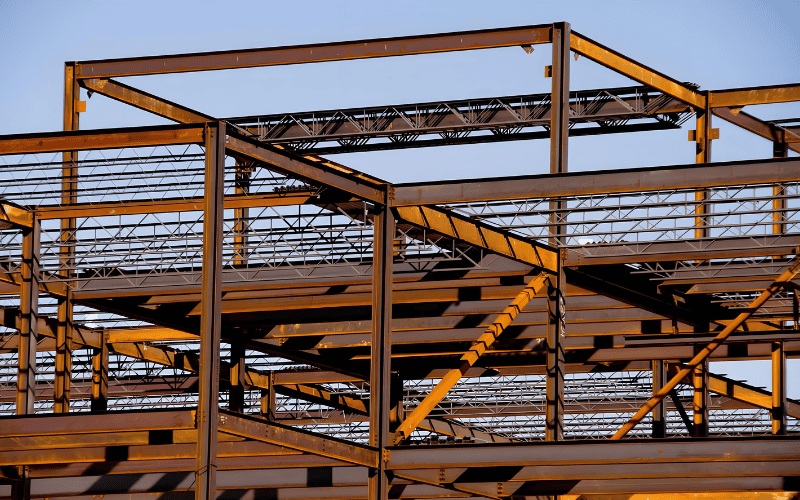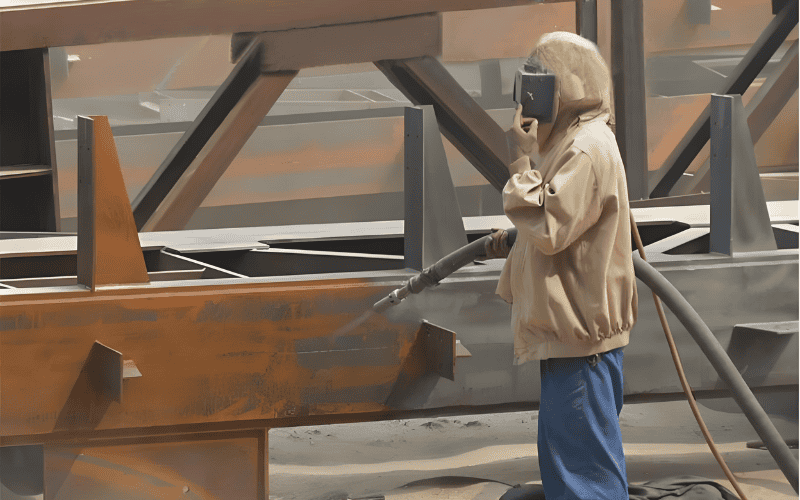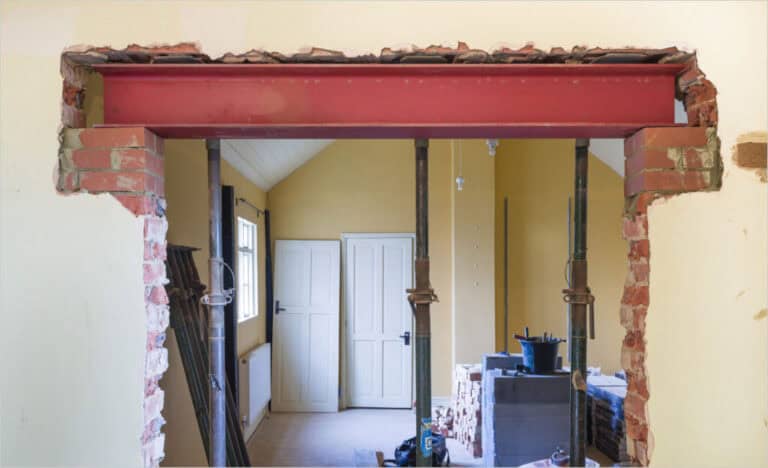Steel structures and steel beams play a very critical role in modern buildings. They are known for their strength and durability, carrying the weight of the entire building and ensuring the stability and safety of the building.
Over time, steel will be affected by various environmental factors, especially moisture and pollutants in the air, which can easily lead to rust, which has a certain negative impact on the performance of steel structures.
Next, we will introduce some practical industrial rust removal methods to help you effectively maintain steel structures, extend their service life, and ensure safety and reliability.
Causes and effects of steel structure corrosion
Chemical process of corrosion
Rust is the result of oxidation reaction when steel is exposed to air and moisture. Simply put, iron reacts with oxygen and moisture to produce iron oxides, which form a layer of red rust on the surface of steel. As the corrosion intensifies, moisture will also enter the steel to form crystal water, further accelerating the corrosion process.
The impact of corrosion on steel structures and steel beams:
- Weakened bearing capacity: Rust will make the surface of the steel beam thinner, reduce its tensile and compressive resistance, and thus affect the stability of the overall structure.
- Increase maintenance costs: Severely corroded steel needs to be repaired or replaced, which undoubtedly increases maintenance costs.
- Safety hazards: Long-term corrosion may cause structural problems and even affect the safety of the building.
By understanding the causes and effects of corrosion, we can better prevent and solve corrosion problems and ensure the long-term stability and safety of steel structures and steel beams.
Rust removal methods for steel beams and steel structures
Different rust removal methods can be selected according to the size of the steel, the degree of rust and the working environment. Common rust removal methods mainly include mechanical rust removal, chemical rust removal and laser rust removal.
Mechanical rust removal
| Method | Principle | Advantages | Applicable Scenarios |
| Sandblasting | High-pressure air is used to shoot abrasives (like steel grit or silica sand) onto the steel surface to remove rust. | High efficiency, suitable for large-scale treatments. | Large steel structures, bridges, ships, and areas requiring extensive cleaning. |
| Shot Blasting | Centrifugal force is used to project steel shot onto the steel surface, removing rust through impact. | Fast processing speed, suitable for bulk treatment. | Prefabricated steel beams, large equipment in factory settings, typically for mass production. |
| Angle Grinder & Wire Brush | Mechanical friction is used with an angle grinder or wire brush to remove the rust. | Flexible operation, ideal for localized treatment. | Small steel beams or localized rust on steel, especially in areas where large equipment is impractical. |
Chemical Rust Removal
Pickling
- Principle: Use acids such as phosphoric acid and hydrochloric acid to dissolve the rust layer. The pickling process can remove rust and other surface contaminants and restore the original surface state of the steel. It is usually combined with surfactants to improve the processing efficiency and reduce damage to the steel.
- Advantages: Pickling is particularly suitable for treating areas with complex shapes or difficult to access, such as gaps or grooves on steel beams. This method can completely remove the rust layer and provide a good foundation for subsequent surface treatment (such as coating or painting).
- Application: Pickling is very common when batch processing steel beams or steel structures in factories, such as for cleaning bridge components, industrial equipment or prefabricated steel components.
Rust Converter
- Principle: Convert rust into stable compounds (such as iron phosphate) through chemical reactions to form a protective layer to prevent further rust. Unlike pickling, rust converters do not need to completely remove the rust layer, just apply it on the surface.
- Advantages: Simple operation, suitable for the treatment of mild rust, and no complex equipment is required. At the same time, it can reduce the risk of further corrosion of steel, saving processing time and cost.
- Application: Rust converters are particularly suitable for lightly rusted steel beams or components, such as early rust areas found during maintenance cycles. It is a fast and economical treatment method.
Laser rust removal
Principle: Use a high-energy laser beam to irradiate the surface of the rust layer, evaporate the rust layer through high temperature, and keep the substrate intact.
Advantages: Laser rust removal has extremely high precision and non-destructiveness, will not cause any mechanical or chemical damage to the steel substrate, and can also keep the steel surface smooth and intact. It is an environmentally friendly non-contact cleaning technology that does not produce chemical residues.
Application: Laser rust removal is often used for precision parts or scenes with high surface quality requirements, such as aerospace equipment, precision instruments or decorative steel for high-end buildings.
High-pressure water jetting (Water Jetting)
Principle: Use ultra-high-pressure water flow to impact the surface of the steel, peel off the rust layer and dirt, without the need for chemical additives, and without damaging the steel surface.
Advantages: High-pressure water jet does not use chemicals, so it is environmentally friendly and suitable for scenarios with high environmental protection requirements. In addition, it can remove dirt and attachments on the surface of steel.
Application: This method is suitable for large steel structures such as bridges, ships or offshore platforms. Especially in outdoor construction, it can complete rust removal work quickly and safely.

Steel structure protection method after rust removal
After completing the rust removal of steel beams and steel structures, we will provide the following professional protection solutions according to the use environment and customer needs to ensure long-term anti-rust effect and extend service life:
Galvanizing
We recommend hot-dip galvanizing or electro-galvanizing to cover the steel surface with a corrosion-resistant zinc layer.
- Principle: The zinc layer preferentially oxidizes through the “sacrificial anode” to protect the steel from corrosion.
- Applicable scenarios: Suitable for outdoor environments such as bridges, fences or steel structures exposed to humid environments.
- Advantages: The protective effect is long-lasting, especially suitable for steel exposed to harsh conditions for a long time.
Anti-Corrosion Paint
We use high-quality anti-rust primer and topcoat to provide double protection for the steel surface.
- Principle: The paint forms a barrier that effectively isolates oxygen and moisture to prevent rust.
- Applicable scenarios: Widely used in industrial steel structures, building steel beams and indoor steel.
- Advantages: Cost-effective, flexible construction, rich color selection, can meet the needs of a variety of scenarios.
Powder Coating
We provide electrostatic powder coating solutions to meet the needs of high performance and aesthetics.
- Principle: Electrostatically spray powder and heat cure to form a uniform and solid protective layer.
- Applicable scenarios: Industrial equipment, mechanical parts and steel components for architectural decoration.
- Advantages: Strong wear resistance, excellent anti-corrosion effect, smooth and beautiful appearance, suitable for high-demand occasions.
By choosing the right protection method, our team will ensure that your steel structure not only meets the performance requirements, but also is satisfactory in appearance, providing higher added value for the project.
Rust removal grade standards for steel beams and steel structures
In the protective treatment of steel materials, the evaluation of rust removal quality is very important. According to international standards, rust removal grades are mainly divided into two categories: sandblasting/shot blasting rust removal grade and manual/power tool rust removal grade. The following are the specific definitions of each grade:
Sandblasting/shot blasting rust removal grade
Sa1: Mild treatment
By sandblasting/shot blasting, loose rust, scale and attachments are removed, which is suitable for basic treatment of surfaces that are not severely rusted.
Sa2: Thorough treatment
Further remove most of the rust layer on the surface of the steel, leaving only slight spots or traces on the surface, which is suitable for general protection needs.
Sa2.5: Very thorough treatment
The surface rust layer is almost completely removed, only very small stains or rust marks are allowed, and the surface of the steel after treatment has a uniform roughness, which is a high standard commonly used in industry.
Sa3: Complete cleaning
The steel surface is completely clean, showing a uniform metallic luster, without any rust, stains or scale, which is the highest level of rust removal standard.
Hand/power tool rust removal grades
St2: Thorough treatment
Loose rust and attachments are removed by hand tools (such as wire brushes) or power tools, but there will still be some firmly attached rust marks on the surface.
St3: Very thorough treatment
Further treatment based on St2 makes the steel surface smoother and cleaner, suitable for higher protection requirements for local areas.
What we recommend
- Selection criteria: Choose the appropriate rust removal grade according to the purpose of the steel, the degree of rust and the protection requirements. For example, Sa2.5 and Sa3 are suitable for industrial and bridge projects with higher requirements, while St2 and St3 are more suitable for local treatment or situations with less rust.
- Combined with subsequent treatment: High-level rust removal can better improve the adhesion of subsequent coatings or plating to ensure long-term protection.
Whatever rust removal grade your project requires, we can provide professional and high-quality solutions based on specific needs.

How to choose the right rust removal method for steel beams and steel structures
When choosing a rust removal method, balance efficiency, cost and environmental factors based on the degree of rust, structural characteristics and project requirements. We can tailor a solution for your steel structure project to ensure that it meets both technical requirements and budget and environmental standards.
1. Degree of rust
Mild rust: Rust converter or manual/power tool rust removal can be selected, which is suitable for small-scale treatment and economical and efficient.
Moderate rust: Pickling or sandblasting/shot blasting is recommended, which can deeply remove the rust layer and ensure a clean surface.
Severe rust: Use efficient sandblasting/shot blasting or high-pressure water jets to quickly clean stubborn rust layers, suitable for large-area steel structures.
2. Size of steel structures and steel beams
Small parts: Choose laser rust removal or manual/power tool rust removal, which is flexible and precise.
Large structures: Suitable for sandblasting/shot blasting or high-pressure water jets, which can complete large-scale cleaning in a short time.
3. Budget
Low budget: Use manual/power tool rust removal or anti-rust paint combined with light treatment to reduce equipment and construction costs.
High budget: Laser rust removal or high-specification sandblasting/shot blasting can be used, which has better treatment effect and lower maintenance cost in the later stage.
4. Environmental protection requirements
If you need to avoid chemical residues or dust pollution, you can give priority to high-pressure water jet or laser rust removal, which is environmentally friendly and residue-free, especially suitable for projects with high environmental protection requirements.
5. Subsequent treatment
Protective layer needs to be applied: It is recommended to choose high-grade sandblasting/shot blasting (such as Sa2.5 or Sa3) to improve the adhesion and protective performance of the coating.
No additional protective layer is required: Light treatment is sufficient, such as rust conversion agent or St2/St3 manual treatment.
As a steel structure supplier, we are committed to providing you with high-quality steel products to reduce the trouble caused by rust. If you have any questions about the rust prevention needs of steel structures, please contact our team to learn more about solutions.

